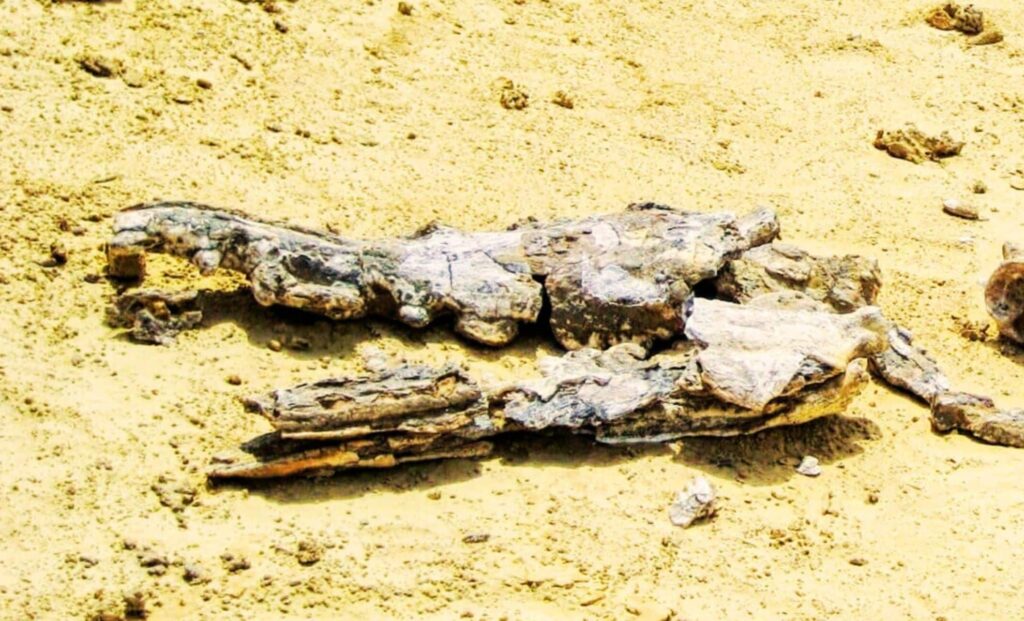In 2006, a farmer in southern Italy noticed several large bones jutting from the muddy bottom of a lake he used to irrigate his fields. It would take him three years of careful water management before scientists could examine what lay beneath. When they did, they uncovered the partial remains of a blue whale—at nearly 85 feet (26 m) long, the largest fossil of the species ever found.
The skeleton, excavated near the town of Matera, is not just remarkable for its size. Radiometric dating suggests the animal lived more than 1.5 million years ago, far earlier than most existing models predicted the emergence of such large body sizes in baleen whales. The find, detailed in a peer-reviewed study published in Biology Letters, has added a significant piece to the puzzle of how Earth’s largest mammals came to be—and is quietly shifting long-held views about their evolutionary path.
A Fossil That Stretches the Evolutionary Timeline
For decades, researchers believed that gigantism in baleen whales, which includes species like the blue and fin whale, was a relatively recent development in evolutionary terms. A widely cited 2017 study proposed that baleen whales only reached massive sizes around 300,000 years ago, driven by changes in ocean productivity during the Pleistocene. The prevailing theory was that a surge in nutrients—due to oceanic upwelling and glacial cycles—created feeding grounds dense enough to support such enormous animals.
But the Matera whale, as it’s now known, predates that window by more than a million years. According to lead paleontologist Giovanni Bianucci of the University of Pisa, the skeleton offers “tangible evidence” that large body size in whales may have evolved gradually, rather than appearing suddenly in response to environmental change.

The fossil also fills a critical gap in the sparse fossil record of large marine mammals from before 2.5 million years ago, a period when ice age cycles and shifting sea levels often buried remains beneath deep sediment or submerged them beneath the ocean floor.
New Clues From an Ancient Skull
Much of what makes the fossil valuable lies in its condition. The nearly intact skull, recovered alongside vertebrae and rib bones, provides scientists with a rare look at the anatomical structure of early blue whales. Unlike other large fossil whale finds, which often consist of partial or crushed bones, the Matera specimen gives researchers a more complete picture of both size and morphology.


The skull, in particular, allows for precise comparisons to modern blue whales, which can grow up to 100 feet in length. While the fossilized whale is slightly shorter, it still ranks among the largest animals ever to live, and its features suggest a direct lineage to modern species.
Felix Marx, a co-author of the study and researcher at the Royal Belgian Institute of Natural Sciences, noted that when the Matera whale was included in existing evolutionary datasets, models began to shift. “The most probable date for the onset of large body size moved back to somewhere between 3.6 and 6 million years ago,” Marx said in an interview. “That’s not a small adjustment—it changes how we understand whale evolution altogether.”
Challenging the “Sudden Shift” Model
The traditional model of whale evolution hinges on the idea that environmental forces—particularly during the late Pleistocene—triggered rapid size increases in baleen whales. These changes, it was argued, offered evolutionary advantages, such as long-distance migration and more efficient foraging in nutrient-rich zones.
The Italian discovery complicates that narrative. If whales of such magnitude already existed 1.5 million years ago, their evolution may not have been tied exclusively to glacial-era food distribution. Instead, size may have increased incrementally over millions of years, possibly influenced by a combination of long-term ecological pressures, including competition, predation, and shifting ocean temperatures.
Some experts caution against drawing definitive conclusions from a single fossil. Graham Slater, an evolutionary biologist at the University of Chicago who co-authored the 2017 study, said the new fossil still falls within the broader timeframe his team proposed. Still, he acknowledged that it lends weight to arguments favoring a more gradual shift. “It’s a data point we’ve been missing,” Slater told National Geographic at the time of the initial study. “We just don’t have many of these fossils from that period.”

